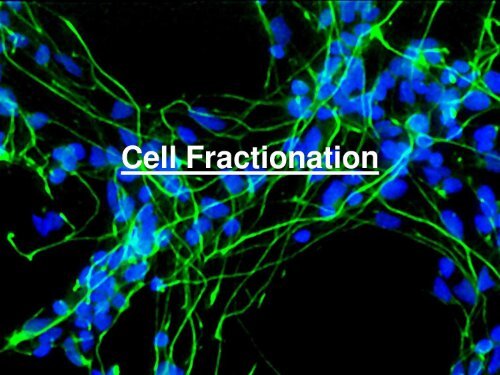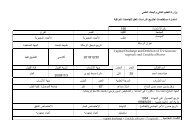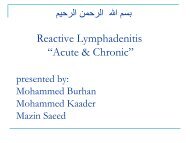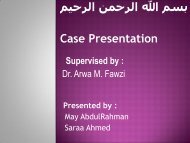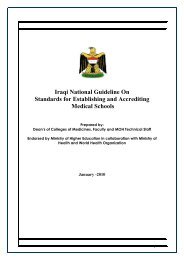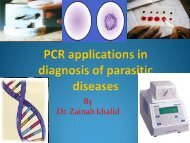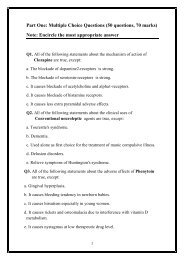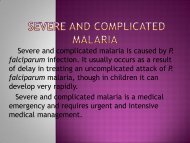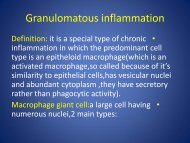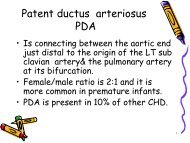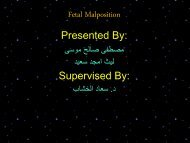What is cell fractionation
What is cell fractionation
What is cell fractionation
Create successful ePaper yourself
Turn your PDF publications into a flip-book with our unique Google optimized e-Paper software.
H<strong>is</strong>torical Introduction
In the early 1700s, Leeuwenhoek noted that avian<br />
and amphibian blood <strong>cell</strong>s contained a “clear area”<br />
almost certainly corresponding to the structure we<br />
now know as the nucleus. Th<strong>is</strong> represents probably the<br />
earliest recognition that eukaryotic <strong>cell</strong>s are not simply<br />
sacs of protoplasm, but instead contain sub<strong>cell</strong>ular<br />
structures. Although the concept of the nucleated <strong>cell</strong><br />
became Þrmly establ<strong>is</strong>hed in the 18th and 19th<br />
centuries, the real beginning of sub<strong>cell</strong>ular<br />
<strong>fractionation</strong> had to await the emergence in the mid-<br />
1940s of the art form known as electronmicroscopy .
The electronmicroscope revealed much more<br />
complexity than Leeuwenhoek could have<br />
imagined. Concurrent with improvements in the<br />
techniques of electron microscopy was the<br />
development of methodologies for sub<strong>cell</strong>ular<br />
<strong>fractionation</strong>. Through the 1950s, these parallel<br />
approaches resulted in the d<strong>is</strong>covery and <strong>is</strong>olation of<br />
the major organelles that compr<strong>is</strong>e the eukaryotic<br />
<strong>cell</strong>. Finally, as biochemical functions were associated<br />
with speciÞc sub<strong>cell</strong>ular compartments, a much<br />
clearer picture of the eukaryotic <strong>cell</strong> began to<br />
emerge, and with it the Þeld of modern <strong>cell</strong> biology.
<strong>What</strong> <strong>is</strong> <strong>cell</strong> <strong>fractionation</strong><br />
• Biolog<strong>is</strong>ts need to study certain<br />
organelles from a <strong>cell</strong> (the<br />
mitochondria of a human <strong>cell</strong> or<br />
the chloroplasts of a plant <strong>cell</strong>, for<br />
example . Isolating these organelles<br />
involves a variety of procedures<br />
collectively called <strong>cell</strong> <strong>fractionation</strong>.<br />
As a method for studying processes<br />
within organelles, <strong>cell</strong> <strong>fractionation</strong><br />
has both advantages and<br />
d<strong>is</strong>advantages.
• Cell <strong>fractionation</strong> <strong>is</strong> where a <strong>cell</strong> are broken up<br />
and its components and organelles are<br />
separated so that scient<strong>is</strong>t can observe them<br />
in <strong>is</strong>olated form .<br />
• It can also be defined as : the separation of<br />
homogeneous sets , usually organelles, from a<br />
larger population of <strong>cell</strong>s.
<strong>What</strong> we’ve learned so far using th<strong>is</strong><br />
technique :<br />
1.Mechan<strong>is</strong>m of protein synthes<strong>is</strong><br />
2.DNA replication and transcription<br />
3.RNA splicing<br />
4.Muscle contraction<br />
5.Microtubule assembly<br />
6.Vesicular transport in the secretory pathway<br />
7.Importance of mitachondria and chloroplasts<br />
in energy interconversions .
Cell <strong>fractionation</strong> methods<br />
Involve the homogenization or destruction<br />
of <strong>cell</strong> boundaries by different mechanical or<br />
chemical procedures, followed by the separation<br />
of the sub<strong>cell</strong>ular fractions according to mass,<br />
surface, and specific gravity
Steps of sub<strong>cell</strong>ular <strong>fractionation</strong><br />
1 . Homogenization<br />
2 . Differential centrifugation<br />
3 . Further separation and purification<br />
by density gradient centrifugation<br />
4 . Collection of fractions<br />
5 . Analys<strong>is</strong> of fractions
1 . Homogenization<br />
First the <strong>cell</strong>s must be broken open. A variety of<br />
different methods are available; the method<br />
chosen depends on the type of experiment and the<br />
type of sample (bacterial culture or mammalian<br />
t<strong>is</strong>sue sample, for example) Detergents like SDS or<br />
Triton X d<strong>is</strong>rupt the <strong>cell</strong> membrane so the contents<br />
can flow out. Subjecting the <strong>cell</strong>s to ultrasound<br />
waves or sonicating them will also break them<br />
open, as will agitation in the presence of metal or<br />
glass beads. Blenders may work with t<strong>is</strong>sue samples<br />
but will not work with bacteria or other<br />
microorgan<strong>is</strong>ms.
Homogenization or Cell D<strong>is</strong>ruption<br />
‣Chemical : alkali, organic solvents,<br />
detergents<br />
‣Enzymatic : lysozyme , chitinase<br />
‣Physical : osmotic shock,<br />
freeze/thaw<br />
‣Mechanical : sonication ,<br />
homogenization, French press
Chemical D<strong>is</strong>ruption<br />
• Detergents such as<br />
Trition X-100 or NP40<br />
can permeabilize <strong>cell</strong>s<br />
by solubilizing<br />
membranes.<br />
• Detergents can be<br />
expensive, denature<br />
proteins, and must be<br />
removed after<br />
d<strong>is</strong>ruption
A sonicator can be<br />
immersed directly<br />
into a <strong>cell</strong><br />
suspension. The<br />
sonicator <strong>is</strong><br />
vibrated and high<br />
frequency sound<br />
waves d<strong>is</strong>rupt<br />
<strong>cell</strong>s.<br />
Sonication
Homogenization<br />
• Cells are placed in a<br />
closed vessel (usually<br />
glass). A tight fitting<br />
plunger <strong>is</strong> inserted and<br />
rotated with a downward<br />
force. Cells are d<strong>is</strong>rupted<br />
as they pass between the<br />
plunger and vessel wall.
2 . Differential centrifugation<br />
<strong>What</strong> <strong>is</strong> Centrifugation<br />
Centrifugation <strong>is</strong> the process of <strong>is</strong>olating<br />
components of a <strong>cell</strong>. There are two common<br />
centrifugation techniques for separating<br />
bacteria components.
Differential Centrifugation<br />
Differential centrifugation <strong>is</strong> the process<br />
where a homogenate (soup of t<strong>is</strong>sue and<br />
<strong>cell</strong>s) undergoes repeat centrifugations and<br />
increasing centrifugal force. Centrifugations <strong>is</strong><br />
the use of increased gravity to quicken the<br />
precipitation of substances tot the bottom.<br />
The tool used here <strong>is</strong> the centrifuge, "merrygo-round<br />
for test tubes" that spin at various<br />
speeds.
The centrifuge separates the <strong>cell</strong>'s parts<br />
into pellet and supernatant. The pellet are the<br />
large <strong>cell</strong> structures that are settled at the test<br />
tube's bottom. The supernatant are smaller<br />
parts of the <strong>cell</strong> suspending in liquid, the<br />
supernatant <strong>is</strong> decanted and undergoes<br />
another centrifugation. The process <strong>is</strong><br />
repeated and increases speed with each trial<br />
to collect successively smaller parts of a <strong>cell</strong> in<br />
pellets.
• These are both test tubes attached to a centrifuge. The first<br />
picture <strong>is</strong> of a test tube that has undergone homogenization but <strong>is</strong><br />
about to undergo centrifugation . The second picture are the<br />
results of the centrifugation and portrays the settling of large <strong>cell</strong><br />
parts.
The preparative ultracentrifuge
• The preparative ultracentrifuge. Sample <strong>is</strong><br />
contained in tubes that are inserted into a ring<br />
of cylindrical holes in a metal rotor. Rapid<br />
rotation of the rotor generates enormous<br />
centrifugal forces, which cause particles in the<br />
sample to sediment. The vacuum reduces<br />
friction, preventing heating of the rotor and<br />
allowing the refrigeration system to maintain<br />
the sample at 4°C.
‣When a centrifugal force <strong>is</strong> applied to an<br />
aqueous mixture, components of larger size<br />
and density will sediment faster<br />
‣Low speed centrifugation <strong>is</strong> used to separate<br />
intact <strong>cell</strong>s from medium<br />
‣High speed centrifugation can be used to<br />
separate sub<strong>cell</strong>ular components
Tow types of centrifuge are there<br />
Fixed-Angle Centrifugation
Swinging-Arm Centrifugation
Method of Differential<br />
Centrifugation:<br />
• 1. Cut t<strong>is</strong>sue in an icecold<br />
<strong>is</strong>otonic buffer.<br />
It <strong>is</strong> cold to stop<br />
enzyme reactions,<br />
<strong>is</strong>otonic to stop<br />
osmos<strong>is</strong> and a buffer<br />
to stop pH changes.<br />
• 2. Grind t<strong>is</strong>sue in a<br />
blender to break open<br />
<strong>cell</strong>s.<br />
• 3. Filter to remove<br />
insoluble t<strong>is</strong>sue
• 4. Centrifuge<br />
filtrate at low<br />
speeds ( 1000 X g<br />
for 10mins )<br />
• Th<strong>is</strong> pellets the<br />
nuclei as th<strong>is</strong> <strong>is</strong> the<br />
densest organelle
• 5. Centrifuge at<br />
medium speeds ( 10<br />
000 x g for 30<br />
mins )<br />
• Th<strong>is</strong> pellets<br />
mitchondria which<br />
are the second<br />
densest organelle
• 6. Centrifuge at<br />
high speeds ( 100<br />
000 x g for 30<br />
mins)<br />
• Th<strong>is</strong> pellets ER,<br />
golgi apparatus and<br />
other membrane<br />
fragments
• 7 Centrifuge at<br />
very high speeds (<br />
300 000 x g for<br />
3hrs)<br />
• Th<strong>is</strong> pellets<br />
ribosomes
Buoyant density centrifugation<br />
The buoyant density centrifugation involves viruses<br />
with densities of 1.1-1.2 g/cm and a sucrose<br />
gradient. The <strong>cell</strong> suspension <strong>is</strong> added to the top<br />
of the sucrose gradient. In th<strong>is</strong> centrifugation the<br />
densest components move fastest down the tube<br />
and stops at the sucrose density equal to its own.<br />
The sucrose gradient bands at the bottom contain<br />
<strong>cell</strong> components with high buoyant densities and<br />
the components at the top have low buoyant<br />
densities.
An illustration of the sucrose gradient and the<br />
buoyant density centrifugation.
4 . Collection of fractions<br />
Collecting Fractions-keeping samples pure<br />
and intact<br />
1.By hand: puncture sidewall of centrifuge tube<br />
with needle and withdraw fractions through<br />
syringe<br />
2.Machine: gradient uploader; introduces very<br />
dense, non-m<strong>is</strong>cible medium into bottom of tube,<br />
pushes fractions up to be collected from top<br />
3.If no pellet, can collect fractions through hole in<br />
bottom of tube
5 . Analys<strong>is</strong> of fractions<br />
Analys<strong>is</strong> of fractions-need to identify and quantify the<br />
purified fractions, so that they can be used successfully<br />
in downstream applications<br />
Methods:<br />
1.Light or electron microscopy<br />
2.Biochemical-determine presence of marker enzymes<br />
3.Assay for a protein marker with an antibody (western)<br />
4.Determine the protein concentration by using a<br />
spectrophotometer, e.g. Bradford assay<br />
5.Determine specific activity (the ratio of activity of<br />
the enzyme of interest to the protein concentration
How <strong>is</strong> <strong>cell</strong> <strong>fractionation</strong> used in <strong>cell</strong><br />
biology?<br />
• Scient<strong>is</strong>ts use th<strong>is</strong> tool to increase their<br />
knowledge of organelle functions. To be able to<br />
do so they <strong>is</strong>olate organelles into pure groups,<br />
such as <strong>is</strong>olating the mitochondria or the<br />
nucleus.<br />
For example, by centrifugation a specific <strong>cell</strong><br />
fraction was determined to have enzymes that<br />
function in <strong>cell</strong>ular respiration. Th<strong>is</strong> unknown <strong>cell</strong><br />
fraction was rich in mitochondria . Therefore<br />
there researchers obtained evidence that helped<br />
determine mitochondria were the site of <strong>cell</strong>ular<br />
respiration.
Investigating Cell Function<br />
• Differential Centrifugation allows us to<br />
look at each organelle within the <strong>cell</strong><br />
• We can look at the individual organelles<br />
and study them in detail<br />
• Th<strong>is</strong> helps to determine each organelles<br />
function within the <strong>cell</strong>
Uses<br />
• Separation of enzymes, hormones, RNA-DNA<br />
hybrids, ribosomal subunits, sub<strong>cell</strong>ular<br />
organelles, for the analys<strong>is</strong> of size d<strong>is</strong>tribution<br />
of samples of polysomes and lipoprotein<br />
fractions.
Represented by


